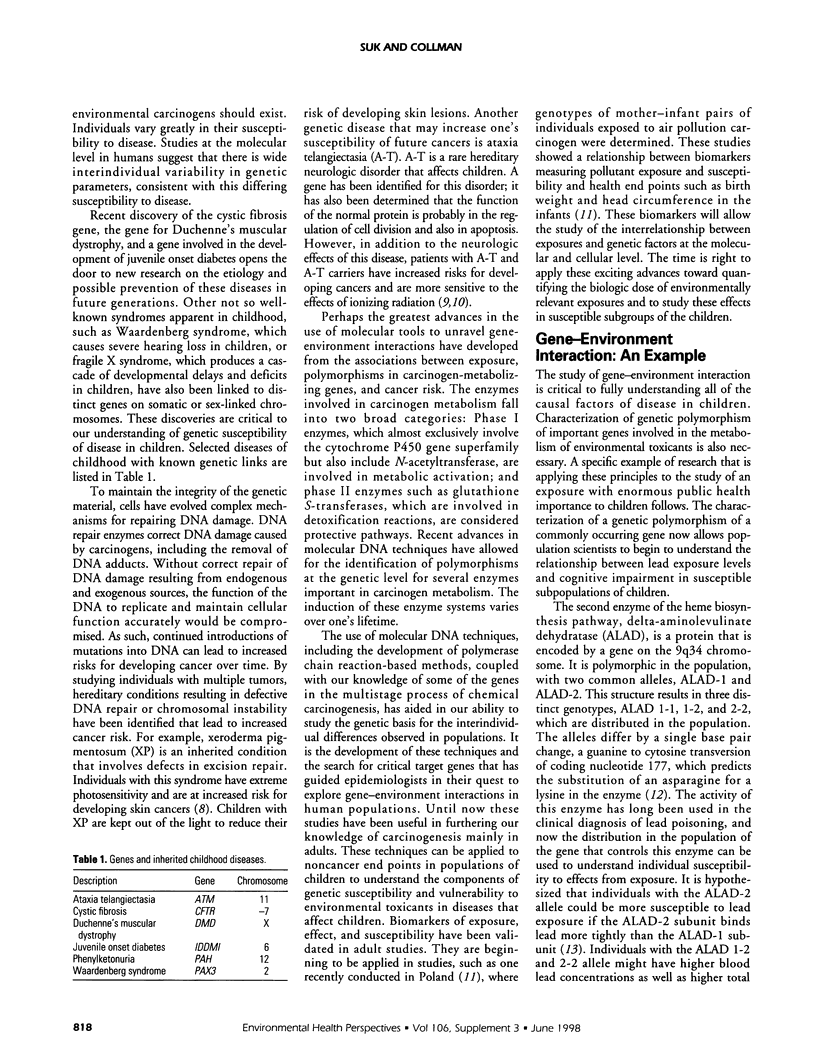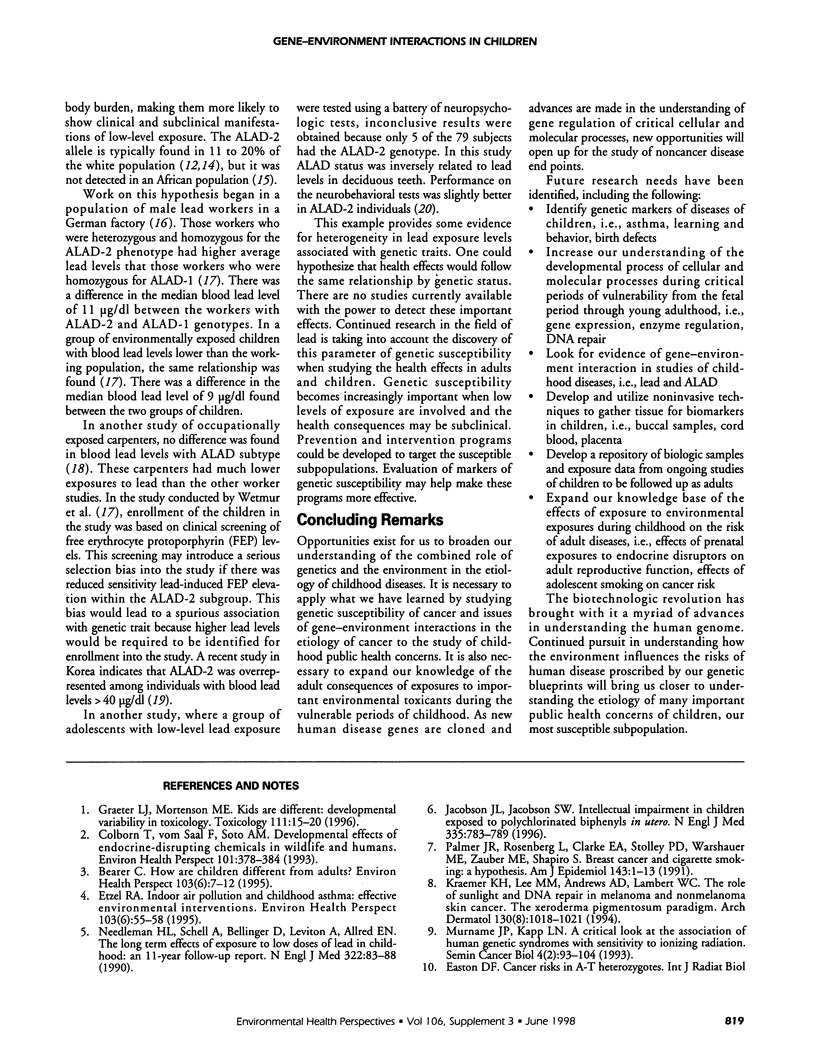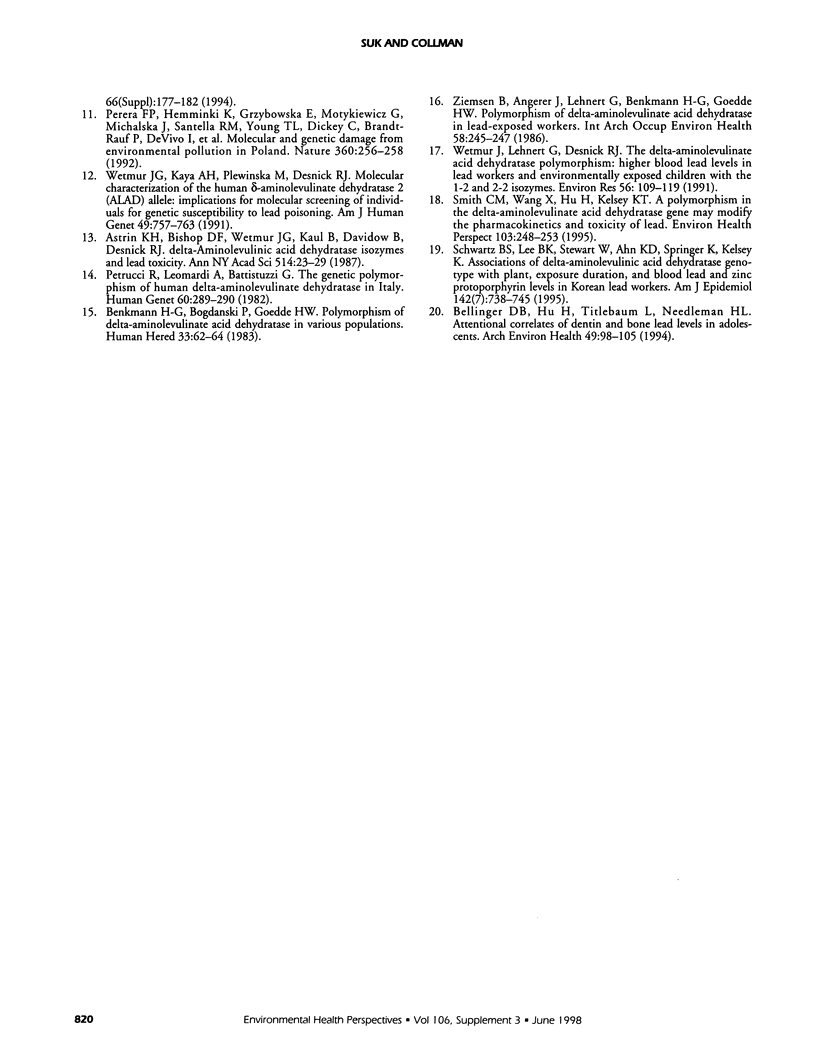Abstract
Because the human population is biologically diverse and genetically heterogeneous, it is not surprising that differences in susceptibility to disease among individuals with or without exposure to environmental agents exist. Individuals vary greatly in their susceptibility to disease. This is true of adults and children. The etiologies of many diseases of childhood are due to a combination of factors, including genetic susceptibility and environmental exposures during vulnerable periods of development. Genes regulate cellular growth and development, DNA replication and repair, the metabolism of endogenous agents in the body, and the metabolism and excretion of exogenous agents that the body comes in contact with in the environment. This regulation varies over the life span, contributing to the cellular consequences of the environmental exposures. This paper summarizes the contributions of genetics in understanding the etiology of environmentally induced diseases in children. The use of biomarkers of genetic susceptibility in the study of these diseases will be discussed. Future research needs for expanding our knowledge of the interactions between genetic and environmental components of childhood diseases will be presented.
Full text
PDF



Selected References
These references are in PubMed. This may not be the complete list of references from this article.
- Astrin K. H., Bishop D. F., Wetmur J. G., Kaul B., Davidow B., Desnick R. J. delta-Aminolevulinic acid dehydratase isozymes and lead toxicity. Ann N Y Acad Sci. 1987;514:23–29. doi: 10.1111/j.1749-6632.1987.tb48757.x. [DOI] [PubMed] [Google Scholar]
- Bearer C. F. How are children different from adults? Environ Health Perspect. 1995 Sep;103 (Suppl 6):7–12. doi: 10.1289/ehp.95103s67. [DOI] [PMC free article] [PubMed] [Google Scholar]
- Bellinger D., Hu H., Titlebaum L., Needleman H. L. Attentional correlates of dentin and bone lead levels in adolescents. Arch Environ Health. 1994 Mar-Apr;49(2):98–105. doi: 10.1080/00039896.1994.9937461. [DOI] [PubMed] [Google Scholar]
- Benkmann H. G., Bogdanski P., Goedde H. W. Polymorphism of delta-aminolevulinic acid dehydratase in various populations. Hum Hered. 1983;33(1):62–64. doi: 10.1159/000153351. [DOI] [PubMed] [Google Scholar]
- Colborn T., vom Saal F. S., Soto A. M. Developmental effects of endocrine-disrupting chemicals in wildlife and humans. Environ Health Perspect. 1993 Oct;101(5):378–384. doi: 10.1289/ehp.93101378. [DOI] [PMC free article] [PubMed] [Google Scholar]
- Etzel R. A. Indoor air pollution and childhood asthma: effective environmental interventions. Environ Health Perspect. 1995 Sep;103 (Suppl 6):55–58. doi: 10.1289/ehp.95103s655. [DOI] [PMC free article] [PubMed] [Google Scholar]
- Graeter L. J., Mortensen M. E. Kids are different: developmental variability in toxicology. Toxicology. 1996 Jul 17;111(1-3):15–20. doi: 10.1016/0300-483x(96)03389-6. [DOI] [PubMed] [Google Scholar]
- Jacobson J. L., Jacobson S. W. Intellectual impairment in children exposed to polychlorinated biphenyls in utero. N Engl J Med. 1996 Sep 12;335(11):783–789. doi: 10.1056/NEJM199609123351104. [DOI] [PubMed] [Google Scholar]
- Kraemer K. H., Lee M. M., Andrews A. D., Lambert W. C. The role of sunlight and DNA repair in melanoma and nonmelanoma skin cancer. The xeroderma pigmentosum paradigm. Arch Dermatol. 1994 Aug;130(8):1018–1021. [PubMed] [Google Scholar]
- Murnane J. P., Kapp L. N. A critical look at the association of human genetic syndromes with sensitivity to ionizing radiation. Semin Cancer Biol. 1993 Apr;4(2):93–104. [PubMed] [Google Scholar]
- Needleman H. L., Schell A., Bellinger D., Leviton A., Allred E. N. The long-term effects of exposure to low doses of lead in childhood. An 11-year follow-up report. N Engl J Med. 1990 Jan 11;322(2):83–88. doi: 10.1056/NEJM199001113220203. [DOI] [PubMed] [Google Scholar]
- Palmer J. R., Rosenberg L., Clarke E. A., Stolley P. D., Warshauer M. E., Zauber A. G., Shapiro S. Breast cancer and cigarette smoking: a hypothesis. Am J Epidemiol. 1991 Jul 1;134(1):1–13. doi: 10.1093/oxfordjournals.aje.a115984. [DOI] [PubMed] [Google Scholar]
- Perera F. P., Hemminki K., Gryzbowska E., Motykiewicz G., Michalska J., Santella R. M., Young T. L., Dickey C., Brandt-Rauf P., De Vivo I. Molecular and genetic damage in humans from environmental pollution in Poland. Nature. 1992 Nov 19;360(6401):256–258. doi: 10.1038/360256a0. [DOI] [PubMed] [Google Scholar]
- Petrucci R., Leonardi A., Battistuzzi G. The genetic polymorphism of delta-aminolevulinate dehydrase in Italy. Hum Genet. 1982;60(3):289–290. doi: 10.1007/BF00303023. [DOI] [PubMed] [Google Scholar]
- Schwartz B. S., Lee B. K., Stewart W., Ahn K. D., Springer K., Kelsey K. Associations of delta-aminolevulinic acid dehydratase genotype with plant, exposure duration, and blood lead and zinc protoporphyrin levels in Korean lead workers. Am J Epidemiol. 1995 Oct 1;142(7):738–745. doi: 10.1093/oxfordjournals.aje.a117705. [DOI] [PubMed] [Google Scholar]
- Smith C. M., Wang X., Hu H., Kelsey K. T. A polymorphism in the delta-aminolevulinic acid dehydratase gene may modify the pharmacokinetics and toxicity of lead. Environ Health Perspect. 1995 Mar;103(3):248–253. doi: 10.1289/ehp.95103248. [DOI] [PMC free article] [PubMed] [Google Scholar]
- Wetmur J. G., Kaya A. H., Plewinska M., Desnick R. J. Molecular characterization of the human delta-aminolevulinate dehydratase 2 (ALAD2) allele: implications for molecular screening of individuals for genetic susceptibility to lead poisoning. Am J Hum Genet. 1991 Oct;49(4):757–763. [PMC free article] [PubMed] [Google Scholar]
- Wetmur J. G., Lehnert G., Desnick R. J. The delta-aminolevulinate dehydratase polymorphism: higher blood lead levels in lead workers and environmentally exposed children with the 1-2 and 2-2 isozymes. Environ Res. 1991 Dec;56(2):109–119. doi: 10.1016/s0013-9351(05)80001-5. [DOI] [PubMed] [Google Scholar]
- Ziemsen B., Angerer J., Lehnert G., Benkmann H. G., Goedde H. W. Polymorphism of delta-aminolevulinic acid dehydratase in lead-exposed workers. Int Arch Occup Environ Health. 1986;58(3):245–247. doi: 10.1007/BF00432107. [DOI] [PubMed] [Google Scholar]


